Food. We all eat it and most of us like it. Where it’s grown and how, though, can have both huge environmental and health impacts. A lot of the food we eat comes from large intensive farms. Intensive farming requires nutrient rich soil but with each crop, nutrients are extracted from the soil. To keep the farm yields up each season farmers use fertilisers, most of which are usually made from oil and gas products. On top of that, little critters who also like to eat said crops need to be kept away and this is achieved with insecticides and pesticides. This is not good for the ecosystem since these little critters are an integral part of the food chain.
In addition, the embodied energy in our foodstuffs is massive. Firstly, seeds need to be grown and processed, land needs to be tilled by diesel guzzling tractors, water pumped to irrigate the crops and fertilisers processed from oil products (yum, oil). Then the crops need to be harvested by big machines, sprayed with preservatives and packaged, usually using plastic. Finally, the food is trucked to your market where you buy it and put it in your fridge. I’ve simplified the process a bit but you get the idea – and the process can be even more energy intensive for meat products. A lot of energy goes into our food. What’s more is a third of that food gets wasted (but hopefully composted), which means the embodied energy in that food has been spent for no good purpose.
As with most climate science and study of human induced environmental impacts, this is all very depressing – but what is the Jiuntu solution to this problem? Local food is a term bandied around a lot these days, especially by our millennial hipster brethren. Whilst there’s no universal definition of ‘local food’, the USDA defines it as marketing arrangements rather than geographical distance between production and consumption. ie. local food is “farmers selling directly to consumers at regional farmers’ markets…” This is much more sustainable than conventional farming for a few reasons. Firstly, the food doesn’t travel hundreds of miles to get from producer to consumer which cuts down on the transport emissions. Secondly, the consumer is empowered to understand how and where the food they buy has been produced. And lastly, the middle-men are cut out of the economic cycle – farmers receive the financial fruits of their labour directly which sustains the process of local food production and incentivises its growth. This isn’t some idealistic hippie philosophy either, with a 2013 United Nations report on agriculture finding that small-scale, organic farming is the only way to sustainably feed the world’s growing population.
Why isn’t this already happening? Partly convenience, partly economics. Humans are inherently lazy. We’d rather go to one shop whenever we run out of food rather than one market every few days which may not have what we want, and hence the supermarket was born. Also, the incredibly large yields of conventional farming drive the cost of producing food/km²/input dollar down with each crop cycle. Economics dictate that this is the driving factor in the food industry which puts intense financial pressure on our local, organic farmer. We could legislate that local food become the status quo but having seen the political clout of the food lobbies, I think it unlikely.
An alternative, and highly sustainable farming practice which has huge potential for local farming is aquaponics. Essentially, aquaponics is a closed loop system where you have a body of water containing fish, and a nearby crop. As the fish do their thing, the ammonia and nitrogen levels in the water rises which feeds the plants. As the plants photosynthesise and grow, they are fed to the fish, which results in a net crop and fish yield. This is then processed for human consumption. Whilst there is an initial net food and energy input, aquaponic farming can become a net zero emissions, fully sustainable food source with the right setup.
I recently met with Steve Adey of Darling Mills Farm located 40km north-west of Sydney, who kindly showed me his commercial aquaponics system.
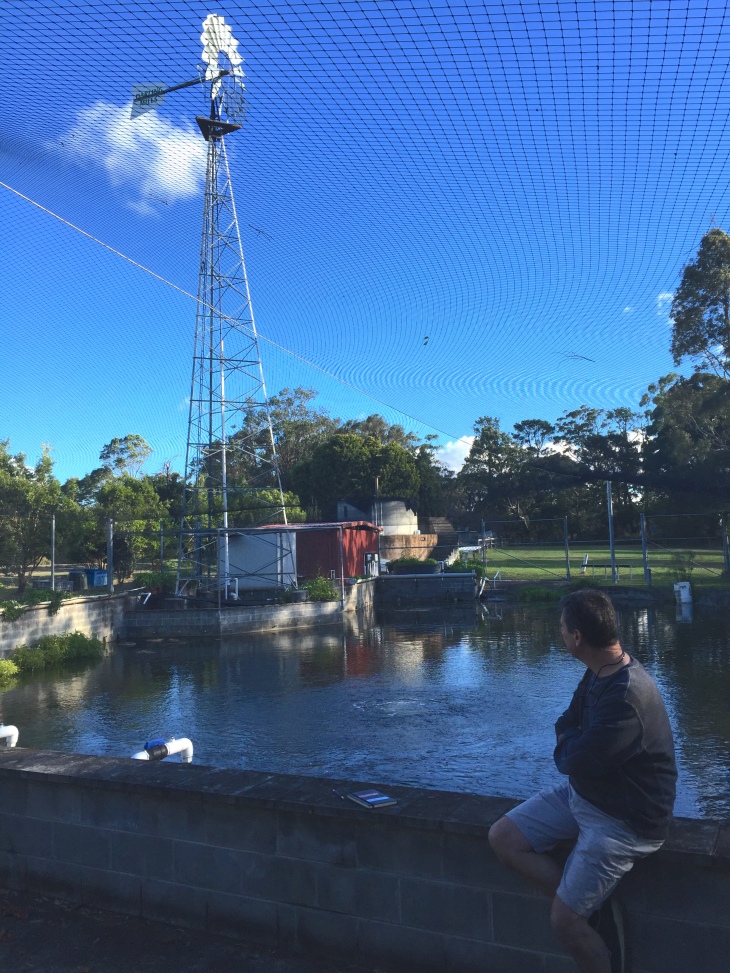
Steve’s got a sweet setup at Darling Mills, with a 750 kL pond which houses both Silver Perch and Australian Bass. He rigged up a net over the pond to protect the fish and plants from birds. The wind turbine directly pumps the water the fish live in to a tank which is used to irrigate the crops in the adjacent paddock. He has a separate electric pump which keeps the water moving when the wind dies down. He also has an air pump which assists in aerating the water. Keeping the water moving and aerated is critical for keeping the water healthy for the fish because these types of systems are susceptible to algal blooms which suck up all the nutrients and kill off edible plants. The water pumps and aeration system require energy which they currently draw from the grid but adding a solar array to power these facilities is one of the next steps in the project.
There are two areas for growing plants: one on the edge of the pond; and one in the adjacent paddock. The pond banks grow duck weed and water spinach which the fish like to eat and they are very effective at filtering the water to reduce its toxicity from the fish excrement.
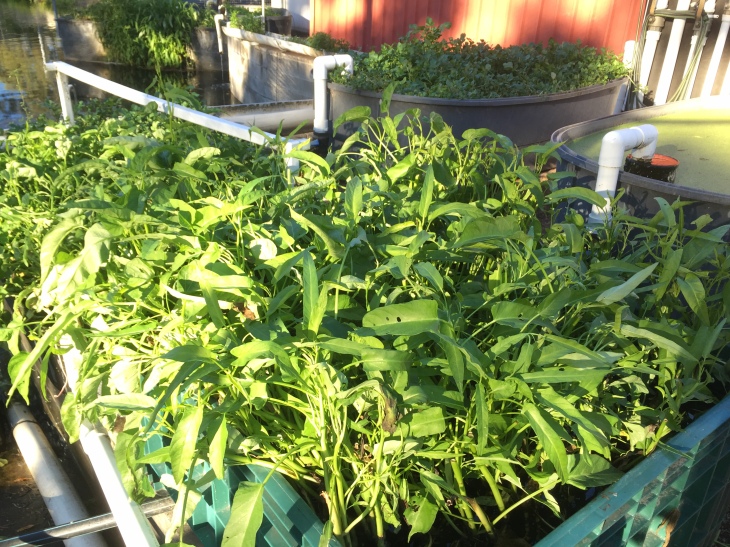
At present Steve’s aquaponics rig is still in the experimental phase and his hydroponics facility generates the majority of Darling Mills’ produce. Hydroponics, which use nutrient rich water beds to grow plants, rather than soil, is more sustainable than conventional farming practices. Even on his hydroponically grown crops, Steve uses organic fertiliser and doesn’t use any pesticides. Aquaponics, however, really is the gold standard in sustainable food production due to the symbiotic relationship between the fish and the plants.
Another oft-lauded form of local food production are community gardens. Several cities around the world now have small, community managed garden facilities where one can plant one’s own crop and nurture it, or simply hang out with other community gardeners. Food doesn’t get much more local than that! It’s also a great way to bring the community together, educate members of the community on issues surrounding food and add some local food to the dinner table. Unfortunately, community gardens are not a viable and secure source of food as this Vox article explains, but its other benefits are certainly tangible.
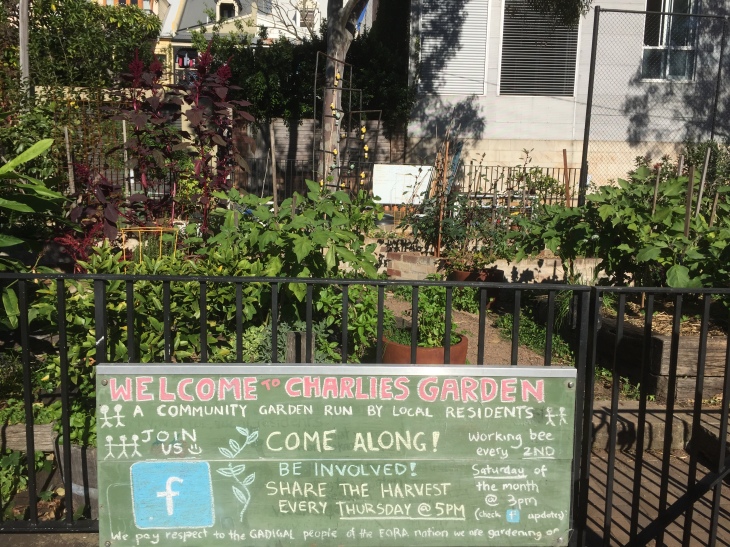
Home agriculture is not for the faint-hearted, either. This summer I dabbled in my own little organic veggie patch which went awry as soon as some hungry rodents stumbled upon my luscious bounty. For some, though, it’s a labour of love as is the case with my green-thumbed friend, Tom Geiser. Tom has set up a home aquaponics system in the garden of his Redfern terrace. His system operates as a scaled down version of Darling Mills’ system and most of his equipment has been repurposed from elsewhere, adding to it’s sustainable credentials. He’s cleverly used gutter and fence space for crop cultivation whilst keeping his fish and duck-weed in 44 gallon drums.
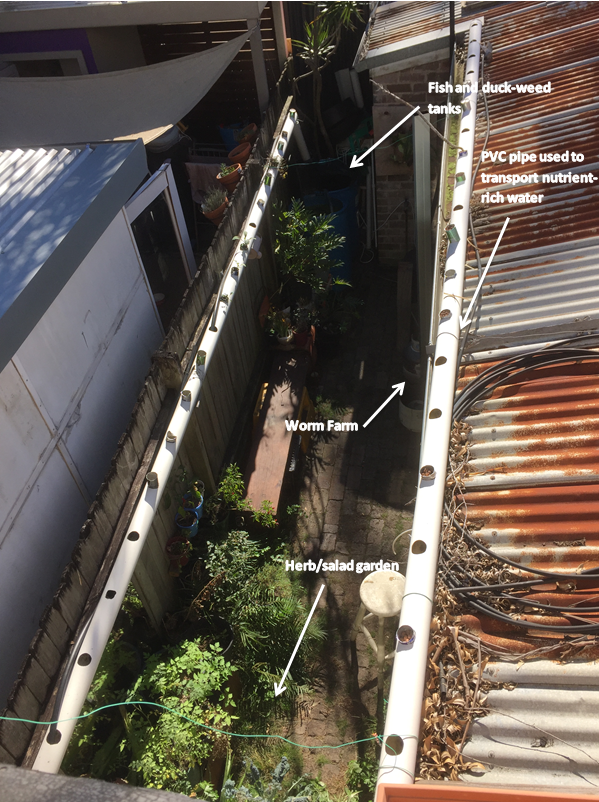
Tom’s set-up is still experimental with several of his seedling pods yet to flourish, though he has successfully grown tomatoes, blueberries, Cavolo Nero, basil, kale, parsely and chillies. He has a school of goldfish and koi, neither of which are good for eating but they are strong breeders which makes them good for aquaponic systems. They are fed with fish food and the duckweed which grows in the next tank. A nice surprise was a family of snails who happily grow with the duckweed and provide added nutrition for the fish, as do the worms from Tom’s home worm farm which is the ultimate form of composting food waste. The worm farm also provides nutrient rich soil in which his crops thrive.
Since this rig uses rainwater collected from the roof, Tom has to add iron and dolomite to buffer the pH of the slightly acidic water. You could just as easily top up the tanks using freshwater but this would detract from its overall sustainability. An electric pump and aeration system are needed to run the system which uses around 1 KWh of energy each day (less than 10% of his household daily usage).
If this all sounds like too much trouble for you, you could fork out for one of these:
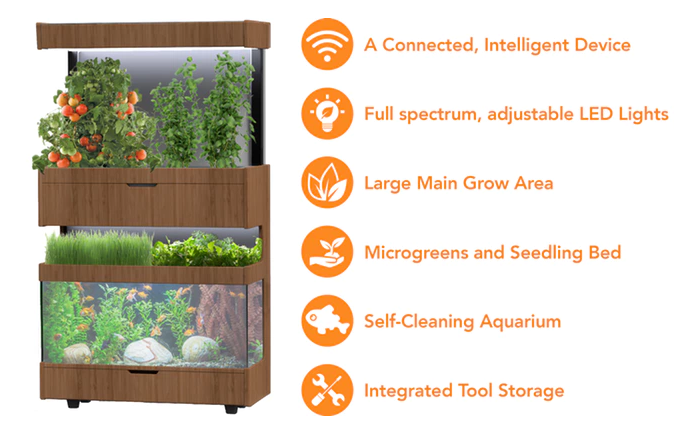
This is a Grove Ecosystem, launched on kickstarter – it’s a home aquaponics system for growing veggies at home. Pair it with a solar power system and rainwater and you’ve got a very sustainable, compact home garden. There’s obviously demand for it because the crowd pledged over four times the goal amount. Unfortunately, they’re still really expensive with even a basic system likely to set you back more than 2500 USD. Those economics are holding it back from appealing to a mass-market but the pledge amount is proof that local food is on the horizon of many.
Whilst the cost-benefit analysis of home-grown food may be questionable, local food is definitely still an attractive option. By buying from local farmers you can vote with your wallet which empowers you, the consumer, to make more sustainable choices. It’s likely a healthier and tastier option, too, with fewer chemicals and processes between the seed and your dinner table.


Thanks for the article. Very interesting! I would like to hear more on how we could support people to transition to local food markets with financial incentives. Unfortunately at the moment bigger is cheaper and only those who have cash to spare can afford the luxury of healthier and more sustainable local food. The sad thing is local food COULD be cheaper than mass produced food if it was supported by government.
Unfortunately regulating agencies like the USDA have an impossible mandate – how can they be expected to protect public/environmental health and the interests of the giant food producers at the same time? In Australia things aren’t as bad as in the US but there is still a long way to go until local, ethical, sustainable food can offer prices as low as at the big supermarkets.
For those interested in this topic, I recommend the movie Food inc. by Robert Kenner – here is an interview with him
LikeLike
Hi GFL, Thanks for reading.
You’re absolutely right that the revolution needs to be led by policy improvements. At present the food lobbies are so powerful that the local farmer can’t compete and so has to charge more for his/her produce. With stronger local farming lobbies we may be able to make in-roads to driving policy to support local farming. Until then, we have to show our support by spending that little bit more and buying local produce.
Food Inc is a great doco and certainly opened my eyes to the issues surrounding our food industry.
LikeLike
Hi,
I enjoyed your articles. Could you please do one on meat/dairy consumption and its impact on climate change?
Thank you
LikeLike
Hi Simon,
Thanks for reading! I certainly can write a post on meat and climate change. I’ll add it to the list of interesting topics and will spin one out soon. Keep reading!
~DS
LikeLike